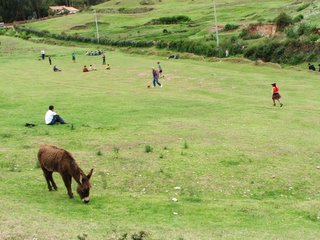
I always enjoy seeing the juxtaposition of old v. new.

And I enjoy watching people enjoy themselves.

But, I'm also a fan of big piles of rocks. This was the sacred site called Sacsuayhuaman (pronounced "Sexy Woman", sort of.) This is where the Incas had their last, best chance to wipe out the Conquistadors. They had 'em surrounded and outnumbered. But, a last ditch breakout saved the Spaniards and sealed the Incas fate. Sacsuayhuaman sits atop a plateau overlooking Cuzco. From here you can see the entire city in the valley below and the snow capped mountains off in the distance. As a group we loved Cuzco and wished to spend more time there. PErhaps one day I will return.


Plaza de Armas from Sacuayhuaman. The Plaza is the center of Cuzco. Cuzco was the navel of the Incan Kingdom.

Kids playing futbol below Sacsuayhuaman.

Self explanatory.

I thought this was interesting. This little bodega was built up against the original wall of an Incan temple. The Incas have been gone for 500 years, but what they did lives on. I guess that's what's so intriguing about them. You know, the Pyramids in Egypt were fascinating, but they were a Necropolis, built to honor dead Pharoahs. The whole culture and peoples of that time are dead and gone (Sorry, Hani). But, the Incans culture lives on in the Mestizo (mixed blood) people who still live high in the Andes and in their physical presence, both sacred and common. The Incan culture as we understand it only existed for about 200 years. Looking at what they accomplished in that amount of time one wonders what they could have become were it not for the introduction of the Old World upon the New.
From here our group reformed, said goodbye to Cuzco and moved on to the Amazon Rainforest.


1 comment:
My apologies. Guess I was overgeneralizing. In the Americas certain tribes (Taino) were wiped out to the man by the Spanish within 25 years of their arrival. So it's at least a little gratifying to find some aboriginal blood still flowing.
Post a Comment